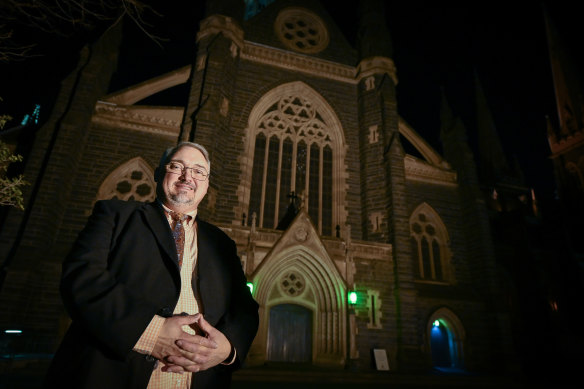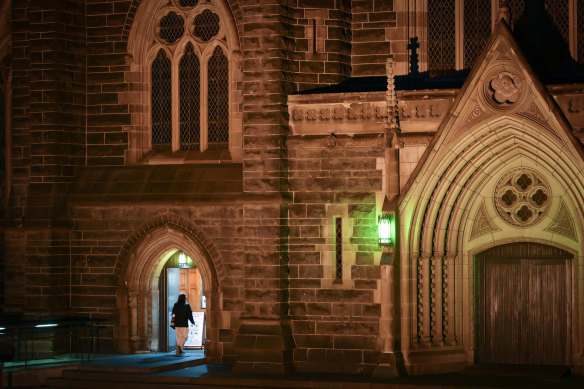This was published 1 year ago
Time to say vale: The end of Latin Mass at St Patrick’s Cathedral
By Najma Sambul
On a cold winter’s night, the pews of the dimly lit St Patrick’s Cathedral in East Melbourne quickly filled with hundreds of worshippers gathered for the final traditional Latin Mass.
The Tridentine Mass, or traditional Latin Mass, first codified in 1570, will no longer be held at the 166-year-old church after Melbourne’s Catholic Archbishop Peter Comensoli made the decision following a request from the Vatican.

William Blevins attends the final Latin Mass at St Patrick’s Cathedral on Wednesday night.Credit: Eddie JIm
Children, some still in school uniforms, were among almost 800 faithful at the cathedral on Wednesday night.
William Blevins travelled from Endeavour Hills in Melbourne’s south-east with his wife and two children for the occasion. Despite not being a regular at St Patrick’s, he was determined to participate in the service.
“When we heard about what was being decided for the diocese, we had to make sure our presence was here,” said Blevins, who attends weekly Mass at the St Aloysius Catholic Church in Caulfield.
Blevins, originally from Brooklyn in New York, said he was disappointed by the change and the broader move away from long-held traditions of the Catholic Church.
“This is the Mass they had for hundreds of years, and it’s also a connection to my past,” Blevins said. “It’s the Mass my mum heard when she was confirmed and the one my grandparents heard.”
A smaller number of Catholics continue to celebrate the traditional Latin Mass compared to the Novus Ordo, or “new order” of Mass, which is usually said in the vernacular and replaced the Mass delivered in Latin as part of the modernising reforms introduced by the Second Vatican Council in the 1960s.
However, Pope Francis’ 2021 letter Traditionis custodes restricted celebration of the traditional Latin Mass and called for bishops to end it in favour of a unified church, amid claims it was being politicised by some conservative Catholics.
The change has come under scrutiny from some priests and members of the Catholic community, who want to see the tradition preserved for future generations.

A worshipper enters St Patrick’s Cathedral on Wednesday night.Credit: Eddie Jim
During his sermon at St Patrick’s, Father Glen Tattersall assured the congregation it wouldn’t be the end of celebrating traditional Latin Mass at the church, which has been held weekly since 2011.
He referred to the views of then bishop George Pell, a leading conservative in the Church, who led a traditional Latin Mass at St Patrick’s in 1992.
“Bishop Pell acknowledged the widespread interest in the Mass he was celebrating,” Tattersall said.
“It was the first traditional Mass celebrated by a bishop in an Australian cathedral since the early 1970s,” he added. “From 1970 or so to 1985, the old Mass had been under a putative ban, until the more enlightened and tolerant approach of John Paul II began to reverse this.
“Bishop Pell continued: ‘This is a precious inheritance. It is not ours to improve or to prune, it is the source of faith, repentance, the source of everlasting renewal. To the extent that we depart from this central tradition of worship and conversion, that we damage or pollute this core, we are weakened and enfeebled.’”
Pell, later a cardinal, who died in Rome in 2023, was Australia’s most prominent Catholic cleric. In 2020, the High Court unanimously quashed historical child sexual abuse convictions against him.
Speaking about the end of Latin Mass, Catholic priest Andrew Hamilton, who has taught theology at the United Faculty of Theology, said the modernised liturgy made it more accessible to people.
“The [Second] Vatican Council revised the old Mass and then put it into everyone’s language,” Hamilton said.

From left: Young worshippers Luca Maher, Kiara Perera, Gabriela Ponce Moya and Lachlan Rourke Holden at St Patrick’s Cathedral. Credit: Eddie Jim
He said that during traditional Latin Mass, some of the prayers are in Latin, and the priest turns his back to the congregation and looks to the front of the church. Incense is used and traditional garments such as veils are worn, and there is a preference for the taking of communion in the mouth from the priest rather than being handed it.
“Because of the emphasis on community and communication in the New Mass, the priest now turns towards the people. The play is the same, but the choreography is different,” he said. “Latin has antiquity, but it was first used because it was modern. It is no more a sacred language than English.”
Hamilton said much of the current resistance to change within the church, whether it be in worship or other ways, is “really a rejection of the changes that took place at the Vatican Council”.
On Wednesday night, at the end of the Latin Mass, a group of young Catholics emerged smiling from the cathedral’s doors. They, like others, had heard about the final service and felt compelled to attend.
Luca Maher, a 19-year-old from Newman College, a Jesuit residential college affiliated with the University of Melbourne, said it was his first traditional Latin Mass. He said he was awed by the number of faithful who attended, but found the service “difficult to follow”.
“There was so much less kneeling in what we would normally do [in the New Mass] ... even the priests just not facing you was a drastic change that I had not experienced, and it was so difficult to follow,” he said.
But for some young people, the beauty and spirit of the traditional Latin Mass was still intriguing, said Lachlan Rourke Holden, 20.
“It’s such an ancient tradition. The history and the beauty and the culture of it has been running on for so long, for it to come to such an abrupt end now ... feels like it’s blowing out the candle on such a beautiful spectacle,” he said.
“Seeing all these other people who are our age there as well, who were covering their hair and were all taking it very seriously ... is a huge inspiration coming from places that have mostly empty pews.”
Get the day’s breaking news, entertainment ideas and a long read to enjoy. Sign up to receive our Evening Edition newsletter here.